
Menu
Close
Close

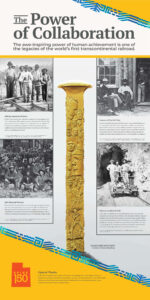
The building of the transcontinental railroad came at a transformational time in our country’s history. The men hired as laborers by the railroad companies came from diverse backgrounds.
During the first few years of the building of the transcontinental railroad, there was a shortage of laborers due to the Civil War. The Union Pacific Railroad Company relied heavily on Irish immigrants to launch the construction. These hard-working men overcame discrimination, lack of supplies, and dysentery from impure water to lay hundreds of miles of rails.
As the nation healed from the Civil War, military veterans found themselves in an uncertain future. When the transcontinental railroad was authorized, Union Pacific raced to find workers willing and able to complete this long and laborious task. Many Civil War veterans were a natural fit for railroad construction because of their experience working in teams, carrying out complicated orders, and navigating less-than-safe or desirable environments.
In 1865, the Union Pacific work crews consisted of approximately 300 African-Americans. This number increased after the end of the Civil War when many freed slaves joined the railroad work crews. In addition to discrimination and the strenuousness of the job, extreme weather conditions during the railroad construction meant these workers faced snow, ice, and unrelenting heat.
As the race to complete the transcontinental railroad continued, both companies were in need of new workers to lay the tracks. Brigham Young and members of the Church of Jesus Christ of Latter-day Saints quickly went to work grading and preparing for the track. From east to west, Mormon graders brought the rails together at Promontory Summit, putting Utah on the map. The transcontinental railroad spurred development and innovation in the state of Utah and helped it become the crossroads of the west.
Captions: Section work crew, Union Pacific Railway, Echo Canyon, Utah Territory, 1869; William Henry Jackson, photographer; Courtesy of the Utah State University Libraries.
Laborers –Irish, Civil War Veterans, and others –in front of Union Pacific paymaster car, Blue Creek, Box Elder County, Utah Territory, 1869; Andrew J. Russell, photographer; Courtesy of the Utah State Historical Society.
Union Pacific Railroad Construction. Andrew J Russell, photographer; Men like these spiked down 425 miles of track in 1868. Gift of M.J. Burson; Courtesy of Utah State Historical Society.
United States Army. Military Railway Service, Russell, Andrew J, photographer. Military railroad operations in northern Virginia: men standing on railroad tracks. United States Virginia, ca. 1862. [or 1863]; Courtesy of the Library of Congress.
Section work crew, Union Pacific Railway, Echo Canyon, Utah Territory, 1869; William Henry Jackson, photographer; Courtesy of the Utah State University Libraries.
Golden Spike Monument, Courtesy of Douwe Blumberg.
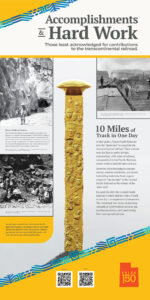
The Central Pacific Railroad Company primarily recruited Chinese immigrants to construct the transcontinental railroad from Sacramento, California, through the Sierra Nevada mountains, to Promontory, Utah. Chinese laborers experienced discrimination, hostile work environments, low pay, and little recognition for their immeasurable contributions to the building of the transcontinental railroad. These workers undertook some of the most back-breaking and hazardous work.
At first glance, Union Pacific Railroad won the “great race” to complete the transcontinental railroad. Their workers were the first to arrive in Utah, constructing 1,086 miles of railroad, compared to Central Pacific Railroad, whose workers laid 690 miles of track.
However, when factoring in extreme terrain, weather conditions, and access to building materials, there is good reason to “tip our hats” to the Central Pacific Railroad as the winner of the “great race”.
On April 28,1869, the Central Pacific Railroad workers laid ten miles of track in one day – an impressive achievement. The event took two weeks of planning. Upwards of 3,000 workers acted as one synchronized army, each performing their own specialized task.
Captions: Chinese tea carrier with tea kegs slung over his shoulders, east front of Tunnel, No. 8, Sierra Nevadas Mountains, California, 1867; Alfred A. Hart, photographer; Courtesy of the Stanford University Libraries.
Chinese railroad workers near the summit, Sierra Nevada Mountains, Central Pacific Railway, circa 1867; Alfred A. Hart, photographer; Courtesy of the Stanford University Libraries.
“Railroad Camp near Victory (where Central Pacific declared “victory,” six miles into the track laying);” taken some days after April 28,1869; Alfred A. Hart, photographer. Courtesy of Stanford University Libraries.
Golden Spike Monument, Courtesy of Douwe Blumberg.
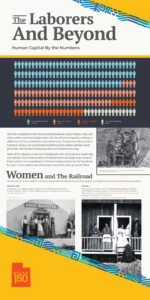
After the completion of the transcontinental railroad, many Chinese, Irish, and other workers continued employment with the railroad companies, working on additional rail line construction and maintenance. Employment sites ran from Canada to Mexico; job assignments included section workers and line repair personnel, who focused on keeping trains and commerce moving.
Many of the employees who were immigrants were not treated as equals and were forced to live on the outskirts of railroad towns and larger cities. Some of these outskirt towns populated by Chinese immigrants became the foundation for some of the modern-day Chinatowns located in cities across the West.
Women were not hired as laborers to build the transcontinental railroad; however, their support was integral to the success of this historic undertaking.
Women made a living working or setting up businesses in pop-up railroad towns from Omaha to Sacramento. Jobs they undertook included working as housekeepers, laundresses, cooks, seamstresses, entertainers, and prostitutes.
Tens of thousands of mothers, wives, and children from China, Ireland, and elsewhere were left behind when their sons, fathers, and husbands traveled to work on the railroad. While many laborers sent funds home, these women and children undoubtedly experienced hardships and had to adapt to a new way of life.
Captions: Pacific Railway section workers on railroad hand cart in Echo Canyon, Utah, circa 1869-1870; E. & H.T. Anthony & Co., Publisher; Courtesy of the Bancroft Library, University of California.
Staff of the Daily Reporter in Corinne, Utah.
Mrs. Hannah Strobridge entertaining workers and guests circa 1868. Alfred H. Hart, photographer, Courtesy Stanford University Libraries.
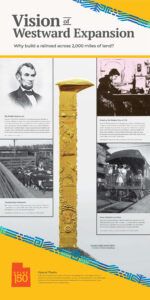
As early as the 1830s, the United States began exploring the idea of building a railroad to connect the country and expand travel opportunities to the Pacific Ocean. In the early 1860s, the vision and advocacy of two prominent figures, Theodore Judah and Abraham Lincoln, defined the path forward. The United States Congress passed the Pacific Railway Act on July 1, 1862. With President Lincoln’s signature, the Act dictated the 41st Parallel, or Central Route, as the route for the transcontinental railroad.
The transcontinental railroad transformed many aspects of life in the United States during the 1800s. This rail line spanning the continent facilitated commerce and westward expansion.
Many of the foundations of our modern way of life can be linked to the completion of the transcontinental railroad. This country-spanning railroad and the telegraph were two of the most significant infrastructure projects in the world. These innovations enabled more rapid dissemination of information and ideas to people living in both urban and rural areas. Newspapers, magazines, and other expressions of ideas and culture became commonplace across the United States.
Building the transcontinental railroad enabled the expansion west by shortening travel times. What was once a 4–6 month trip by wagon from the East Coast to the West Coast was cut drastically to a 6-day journey by rail, forever changing our perception of distance and time.
Captions: Portrait of Abraham Lincoln, Courtesy of Wikimedia.
Cattle being transported by rail in Utah. Courtesy of Union Pacific Railroad Company and Utah State Historical Society.
Female telegraph operator taps out Morse Code message. Drawing from Harper’s Weekly. Courtesy of Utah State Historical Society.
Passengers of Rio Grande Western Railway Company near Castle Gate, Utah. Courtesy Utah State Historical Society.
Golden Spike Monument, Courtesy of Douwe Blumberg.
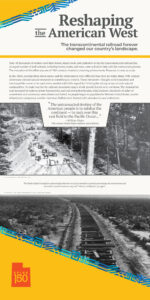
Tens-of-thousands of workers used their brawn, simple tools, and explosives to lay the transcontinental railroad line. An equal number of draft animals, including horses, mules, and oxen, were utilized to help with the construction process. The execution of this effort was one of 19th-century America’s crowning achievements. However, it came at a cost.
In the 1860s, popular ideas about nature and the environment were different than they are today. Many 19th-century Americans viewed natural resources as something to control. These resources—thought to be boundless and inexhaustible—were to be used when needed with little regard for limiting the taking or use of such natural commodities.
To make way for the railroad, mountain ranges of old-growth forests were cut down. The demand for coal increased in order to power locomotives, and coal extraction became a big business. Hundreds of miles of watersheds and waterways were altered and fouled. As people began to populate the Western United States, swaths of land were overgrazed, and the American Buffalo were hunted with abandon to near extinction.
Captions: Central Pacific Railroad workers in the foothills of the Sierra Nevada mountains.
“Advance of Civilization.” End of the Track near Iron Point, circa 1868; Alfred A. Hart, photographer. Courtesy of Stanford University Libraries.
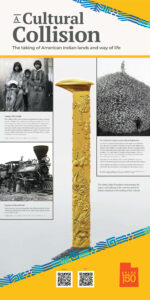
The building of the transcontinental railroad had dire effects on many American Indians who lived throughout the areas along the rail route. Many resisted the railroad construction to defend their independence and way of life. Not only were scores of tribes displaced from their ancestral land, the resources they depended on, such as native animals and other natural resources, diminished as a result of the new rail line. American Indian nations affected include the Cheyenne, Sioux, Arapaho, Shoshone, Paiute, and many more.
There were some American Indian tribes that offered support for the railroad construction, including the Paiute for the Central Pacific and the Pawnee for the Union Pacific.
As various railroads crossed the plains, market hunters decimated the bison (also known as buffalo) population for profit. Trains shipped vast amounts of bison hides to multiple markets. The rise of a manufacturing economy demanded stronger belts made of bison leather to drive factory machines. City diners enjoyed feasting on bison tongue, a delicacy. Soon, bison carcasses littered the plains, and bone collectors gathered the remaining bones to produce fertilizer.
Naturalists estimate that by 1900, less than 1,000 bison remained. The loss of this animal caused tremendous suffering for the Plains Indians.
Today, small groups of bison roam across a fraction of the lands once occupied by the vast herds that once dominated the American West.
Captions: Paiute family near Reno, Nevada, 1868, Alfred A. Hart, photographer. Courtesy of the Getty Museum.
Shoshone Indians looking at a locomotive on the desert. Alfred A. Hart, photographer. Courtesy of Stanford University Libraries.
Tens of thousands of buffalo skulls piled up. Millions of Buffalo, which had roamed freely from the Wyoming high plains to the Great Plains, were driven to near extinction, in part by hunters brought by the railroad. Courtesy of Wikimedia Commons.
Golden Spike Monument, Courtesy of Douwe Blumberg.
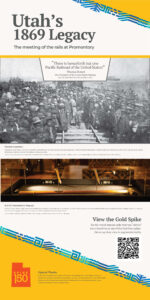
The decision about where to meet the Union Pacific and Central Pacific Railroads required nationwide cooperation. A visit by a commission of the Interior Department commission and a joint resolution on April 10, 1869, were required to confirm the decision to join the rails in the Utah territory at Promontory Point.
On May 10th, 1869, the final spikes were placed, marking the completion of the world’s first transcontinental railroad. When the mallet struck the final golden spike, everyone across the country knew the “wedding of the rails” was done with three taps on a telegraph.
See the world-famous spike that was “driven” into a laurel tie as one of the final four spikes. Get an up close look in augmented reality.
Captions: “Last Rail is Laid”, moments before the spikes were tapped into place; Leland Stanford (Central Pacific, President) holding up mallet, Thomas Durant (Union Pacific Vice-president) also with a mallet, and Sidney Dillion (Union Pacific Vice-President) holding up the gold spike; Alfred A. Hart, photographer; Courtesy of the Stanford University Libraries.
The gold and silver spikes and Thomas Durant’s mallet from the ceremonial driving of the spike. Photograph by Todd Anderson. Courtesy of the Utah Department of Cultural & Community Engagement.
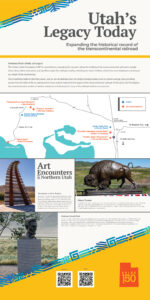
The Golden Spike Foundation (GSF) is committed to expanding the narrative about the building of the transcontinental railroad to include those whose labor, innovation, and sacrifices made this railroad a reality, including the Native Americans, whose lives were displaced or destroyed as a result of the construction.
The Foundation believes that film, music, and art are all mediums that can bridge learning barriers such as cultures and ages, thus providing people from all walks of life to learn and be inspired by the legacy of the transcontinental railroad. In this spirit, the Foundation has commissioned a number of artistic endeavors to help keep the story of the railroad workers ever present.
Viewed from the Golden Spike National Historical Park visitor center, Ilan Averbuch’s work is dedicated to the unsung laborers of the transcontinental railroad. Installed in June 2022, the piece rises and curves to the right, visually crossing the plains mountains on a viewer’s journey to the unknown. Much like the story of the transcontinental railroad, the piece encourages viewers to think critically, and with emotion, about the complex history and its implications for the primarily immigrant labor force involved in its construction..
A majestic, life-sized bison sculpture gazes across lands where wild bison once roamed. The 3,000-pound bronze sculpture sits adjacent to the Golden Spike National Historical Park visitor center and is a tribute to the powerful forces that united east and west by rail. The sculpture serves as a reminder for future generations to honor and respect the history of the railroad and to understand the impact on Native American populations and the natural world.
As early as the 1830s, the United States began exploring building a railroad to connect the country. With President Lincoln’s signature, the 1862 Pacific Railway Act dictated that the 41st Parallel or Central Route was the preferred transcontinental railroad route and paved the way to aid in its construction. To honor President Lincoln’s legacy with the transcontinental railroad, in 2022, the GSF commissioned Daniel J. Fairbanks, the great-grandson of renowned Utah painter John Fairbanks and grandson of sculptor Avard Fairbanks, to create a bust of President Abraham Lincoln. The sculpture will reside at Golden Spike Park at Reeder Ranch; its position will serve as a gateway for the trails within the park.
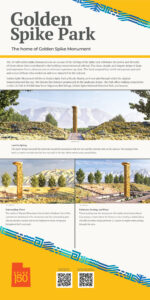
The 43’ tall Golden Spike Monument you see as part of the Driving of the Spike tour celebrates the power and diversity of those whose labor contributed to the transcontinental railroad. The clean, simple and elegant design is meant to be both large and impressive from a distance and also an intimate experience up close. The hand sculpted bas reliefs incorporate portraits and scenes of those who worked on and were impacted by the railroad.
Golden Spike Monument will live at Golden Spike Park at Reeder Ranch, an 8-acre plot through which the original transcontinental line ran. The historic line features prominently in the landscape design. The Park offers walking connections to the U.S. Fish & Wildlife Bear River Migratory Bird Refuge, Golden Spike National Historical Park, and beyond.
The park’s design will mold the landscape around the monument with the cuts and fills typically seen on the railroad. The shaping of the land is a subtle reminder that the line was built in the late 1860s mainly using manual labor.
The northern Wasatch Mountains that sit above Brigham City will be a prominent backdrop for the monument and the surrounding park. The mountains conceal and reveal themselves from varying views throughout the 8-acre park.
Tiered seating near the monument will enable schools and cultural tour groups to learn about the history on site. Finally, a shaded plaza will offer travelers along Interstate 15 a place of respite when passing through the area.
Caption: Courtesy of LOCI Design
Special thanks to the Utah Department of Cultural & Community Engagement, with support from the George S. and Dolores Dore Eccles Foundation, for their use of content from their 2019 exhibit, Treasures of the Transcontinental Railroad. Additional thanks to Brad Westwood, former director of the Utah Division of State History.
